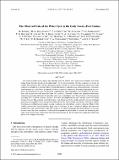The Observed State of the Water Cycle in the Early Twenty-First Century
Author(s)
Rodell, M.; Beaudoing, H. K.; L’Ecuyer, T. S.; Olson, W. S.; Famiglietti, J. S.; Houser, P. R.; Adler, R.; Bosilovich, M. G.; Clayson, C. A.; Chambers, D.; Clark, E.; Fetzer, E. J.; Gu, G.; Hilburn, K.; Huffman, G. J.; Lettenmaier, D. P.; Liu, W. T.; Robertson, F. R.; Sheffield, J.; Wood, E. F.; Schlosser, Courtney Adam; Gao, Xiang; ... Show more Show less
DownloadRodell-2015-The observed state o.pdf (1.704Mb)
PUBLISHER_POLICY
Publisher Policy
Article is made available in accordance with the publisher's policy and may be subject to US copyright law. Please refer to the publisher's site for terms of use.
Terms of use
Metadata
Show full item recordAbstract
This study quantifies mean annual and monthly fluxes of Earth’s water cycle over continents and ocean basins during the first decade of the millennium. To the extent possible, the flux estimates are based on satellite measurements first and data-integrating models second. A careful accounting of uncertainty in the estimates is included. It is applied within a routine that enforces multiple water and energy budget constraints simultaneously in a variational framework in order to produce objectively determined optimized flux estimates. In the majority of cases, the observed annual surface and atmospheric water budgets over the continents and oceans close with much less than 10% residual. Observed residuals and optimized uncertainty estimates are considerably larger for monthly surface and atmospheric water budget closure, often nearing or exceeding 20% in North America, Eurasia, Australia and neighboring islands, and the Arctic and South Atlantic Oceans. The residuals in South America and Africa tend to be smaller, possibly because cold land processes are negligible. Fluxes were poorly observed over the Arctic Ocean, certain seas, Antarctica, and the Australasian and Indonesian islands, leading to reliance on atmospheric analysis estimates. Many of the satellite systems that contributed data have been or will soon be lost or replaced. Models that integrate ground-based and remote observations will be critical for ameliorating gaps and discontinuities in the data records caused by these transitions. Continued development of such models is essential for maximizing the value of the observations. Next-generation observing systems are the best hope for significantly improving global water budget accounting.
Date issued
2015-10Department
Massachusetts Institute of Technology. Center for Global Change Science; Massachusetts Institute of Technology. Department of Earth, Atmospheric, and Planetary SciencesJournal
Journal of Climate
Publisher
American Meteorological Society
Citation
Rodell, M., H. K. Beaudoing, T. S. L’Ecuyer, W. S. Olson, J. S. Famiglietti, P. R. Houser, R. Adler, et al. “The Observed State of the Water Cycle in the Early Twenty-First Century.” J. Climate 28, no. 21 (November 2015): 8289–8318. © 2015 American Meteorological Society
Version: Final published version
ISSN
0894-8755
1520-0442